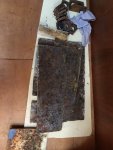Hoolie
Well-Known Member
From my flooded sump experience I would suggest you just use pure clean water as any detergent will leave a film of emulsified diesel/water in the tank. Pressure washing sounds a good way of getting into all the crevices!
From my flooded sump experience I would suggest you just use pure clean water as any detergent will leave a film of emulsified diesel/water in the tank. Pressure washing sounds a good way of getting into all the crevices!
Chris,
Just bought one myself from Aylesford as the Karcher I had died. £50 of the queens.......
https://www.aldi.co.uk/search?text=steam cleaner
Thanks for that, got to be worth a try then. Mine is only a cheapie, but it does have a second lance that has some serious power behind it, so worth a go!
Thanks Dave, the price is certainly right! Sorry to be dim, but can the head be removed to give a jet of steam?



Perhaps worth a call ...
https://www.pondlinersonline.co.uk/category/our-product-range/tank-liners/
or this one ...
https://www.duratank.com/tanks-and-liners
have a look at slosh sealant from rustbuster.co.uk,
does say tank needs a clean first tho!
Just had a look inside the box. Lance is removeable,leaving the trigger, which will deliver a 'squirt' of steam
If you can gain working access to all interior surfaces and get them reasonably degreased, then an interior coat of GRP resin with a medium CSM layer and decent gel layer could be a workable option, effectively creating a GRP bladder. You would need to use a resin or epoxy that is 100% diesel tolerant, but I am sure such things exist, and laying up a flat surface is simple.
Good luck but sadly I think you are only delaying the inevitable. 550 litres is a lot of diesel to risk sloshing in your bilges.
I had 2 x 550 tanks in my Nauticat 43. I didn't have a leak but as I was pulling the boat apart decided to replace them as they were full of crap and I couldn't seem to successfully clean them.
I couldn't get them out in one piece so had to cut them out. They turned out to be mild steel and were rusted internally and also externally in the corners and probably a year away from failing.
I designed new tanks with Tek-Tanks and decided on four separate tanks (each one the maximum that would fit through the hatch) joined into two logical pairs with a total capacity of 880 litres (down from 1100). Clear inspection hatches and pick-ups to the lowest points means they are much easier to maintain.
Pics attached - the insides of the tanks after they had been cut out and some pics of the new tanks.
Puggy
View attachment 69273View attachment 69274View attachment 69275
It is perfectly possible to clean and degrease a tank IF you have good access ( need to be able to get a hand into every corner) and that is rarely possible in small boat tanks.
Perhaps worth a call ...
https://www.pondlinersonline.co.uk/category/our-product-range/tank-liners/
or this one ...
https://www.duratank.com/tanks-and-liners
Not been established yet, but I would be surprised if a 550l tank did not have extensive internal baffles which makes any sort of liner or coating the interior with resin and glass impossible.
The reality is unless he can find the leak from the outside and seal it there then the only solution is to do what Puggy did and cut the tank out to replace it.
I do appreciate the pleas to tear the tank out and replace, but as there are no signs of corrosion or damage, and the leak could have been down to that drain plug, it seems a bit overkill at this stage.
Not been established yet, but I would be surprised if a 550l tank did not have extensive internal baffles which makes any sort of liner or coating the interior with resin and glass impossible.
The reality is unless he can find the leak from the outside and seal it there then the only solution is to do what Puggy did and cut the tank out to replace it.
To partially pressurise the tank a wet and dry vac on blow then tape the hose into the filler. I suggest a very strong solution of fairy liquid as the bubble fluid.
If this reveals the precise leak point, and if you can get to it, then after you have degreased it PERHAPS one of these might be worth a try ...
https://www.norelem.com/us/en/Produ...les/LOCTITE/97990-LOCTITE-flange-sealant.html
Use the vacuum on blow again pressurising the tank to push the sealant into the fissure. Once it is in there it hardens by absence of air.
I repaired a steel petrol tank years ago with a two part epoxy, darned if I can identify it now. It was on the shelf at a local engineering supply co.